A recent conversation over in the social medias (join my Dungeons & Dragons 5e group in MeWe) with Cam Banks has me thinking about other takes on elves. In particular, he was looking for lower-magic elves with no cantrips or teleports. There’s not a lot of official content that points in that direction, since he specifically didn’t want to use wood elves or wild elves. Point is, I want to explore some other kinds of elves, particularly drawing on content I’ve loved in Atlanta-area LARP settings (though the Wildlands setting originated in Boston).
Core Elves
First, let’s characterize D&D’s elves. Their strongest influences appear to be Tolkien, including lifting several names from the Silmarillion (see the featured image), but taking only the most Cliff’s Notes versions of themes. The mechanics of 5e elves emphasize:
- Physical grace
- Stealth, especially forest stealth
- Accuracy
- Inborn connection to magic
- Perception
- Not sleeping
There are also mechanics that seem half-hearted efforts to present a theme, such as Elf Weapon Training. It’s a nod to the original elf class as fighter-mage, and its general purpose seems to be a backstop – a hard minimum on how much martial ability a character can have. Proficiency in longswords, shortswords, longbows, and shortbows means one Strength weapon and three Dexterity weapons. Most classes that would want to use those weapons already have them, because (for obvious reasons) they’re otherwise provided them. Melee clerics other than the War domain are one of the only big exceptions. You can play a wizard (other than Bladesigner) with a longsword, but considering what an odd mistake it would be to spend your round using it, the feature is a ribbon.
This is a significant pet peeve for me, as I think is pretty obvious. Partly as a creative exercise, I’m limiting my efforts in this post to subraces – I’m not making changes to the core elf racial features. But hey, Elf Weapon Training stays within that remit! So I’m not dropping +2 Dex, long life, size, speed, darkvision (though I’d like to), keen senses (mostly don’t care), fey ancestry (eh, fine, whatever), trance (I’d really like to can this one, it does nothing for me), or languages.
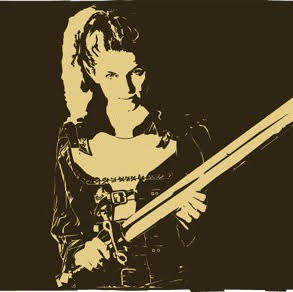
Photo subject Veaya Stembridge. I’ll add the photographer’s name when I find it out. Photo editing by Travis Sharp.
Treefolk
In Shattered Isles and King’s Gate, each nonhuman PC race is connected to one of the elements (Fire, Air, Stone, Wood, Water, Metal). Elves are, of course, the people of Wood, with barkskin and forestblend as racial abilities. They also have a racial restriction such that they become visibly marked (facial makeup requirement) if they break an oath. What would a more tree-ish subrace of elves look like?
- Ability Score Increase. Your Constitution or Wisdom score (your choice) increases by 1.
- Elf Weapon Training. You can your Wisdom ability modifier in place of Dexterity for attack and damage bonuses when wielding longbows or shortbows.
- Forestblend. You gain advantage on Dexterity (Stealth) checks in forests. You can Hide as a bonus action in a forest, and you can hide while adjacent to a tree even if you have no other cover or concealment.
- Barkskin. Your AC can’t be less than 16, regardless of the armor you are wearing.
- Marked by Oath. When you give your word, bond, or oath to someone and the charmed or frightened condition would cause you to break your bond, you can make a new saving throw against that effect with advantage each round. If you break your bond willingly, including willingly submitting to the charmed or frightened condition, you are visibly marked and become outcast from elven society.
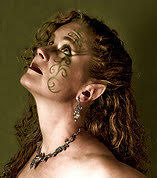
Photo subject Veaya Stembridge, photography by Russell Matthews
Fire Elves
If we’re doing Baskin Robbins 31 Flavors of Elves anyway, I’m going to Wildlands for one or two more. In Wildlands, there are fire, storm, earth, sea, sun, shadow, and dark elves. Because of their cool facial makeup, fire elves were probably the coolest. (Sea elves were what D&D would probably call malenti – looks like an elf, acts more like a sahuagin, no water breathing as far as I recall.)
- Ability Score Increase. Your Strength or Intelligence ability score (your choice) increases by 1.
- Fireborn. You have resistance against fire damage.
- Produce Flame. You can cast the produce flame cantrip. You can choose Intelligence, Wisdom, or Charisma as your spellcasting ability score for this spell.
- Flame Dancing. Starting at 5th level, when you cast the produce flame cantrip, you can also make a melee weapon attack as a bonus action.
Dragaerans
If you know what a Dragaeran is, you probably know that they’re the humans and it’s the Easterners that are… not. If you know what an Easterner is, you probably know that they’re the humans and the Dragaerans are elfs. Each of the Dragaeran Houses is different in minor but observable ways, other than the House of the Jhereg. What they don’t have are meaningfully different in-combat or out-of-combat features from one another. Sure, the Dzur and Dragons are the superior warriors and soldiers, Athyra are the mages, and so on… but still. Those are so much more like class tendencies that I wouldn’t try to load that into race. (I’m also not offering access to the Orb here – since Easterners can gain that too, it’s not a racial feature.)
If you’re not familiar with Dragaerans, the Ability Score Increase below is about the fact that they’re considerably stronger than Easterners.
- Ability Score Increase. Your Strength ability score increases by 1, and one ability score of your choice other than Strength or Dexterity increases by 1. You can reduce the ability score bonus that you receive to Dexterity (from the elf core feature) by 1 and apply it to Strength instead.
- Long Memory. Choose one of Arcana, History, Nature, or Religion. You gain proficiency in that skill, and when you would use Intelligence to make an ability score check with it, you can choose to use Wisdom or Charisma instead.
- Cycle of Reincarnation. You can call up memories from your previous incarnations. At the end of a long rest, choose one tool or language and gain proficiency in it. You lose proficiency in that tool or proficiency when you choose a different tool or language proficiency.
- House Connections. When you would gain or lose renown with any organization, you can invoke your house connections and gain or lose that renown with your House instead. Your starting renown with your House is equal to your Charisma modifier (minimum 1). You can’t use this feature if it would cause your renown to fall below 0.
- This feature is more directly borrowed from Cam Banks’s work, and I would not fail to credit it as such.
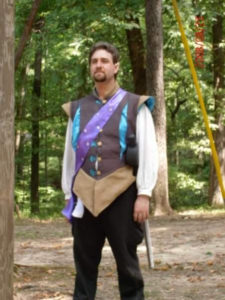
Photo subject Scott Casteel. Photographer unknown.
The Elf Default
Kainenchen had a great idea for a different angle on a setting, and one that’s especially appropriate to Dragaera. What would it look like if all of a setting’s mechanics assumed that elves were the default, but still didn’t believe in ability score penalties (just as 5e did away with them)? You’d finally have mechanics that had to say something interesting about humans. Sure, an actual Dragaeran (other than Zerika, Kragar, or the other protagonist types) would be hard-pressed to stat them as anything fun to play, but let’s skip that for now. Humans would be agile, small, maybe dangerous fencers, probably all gifted in the exotic art of witchcraft…
That’s well beyond the scope of this post, but it would be an interesting project for getting inside the elves’ headspace.
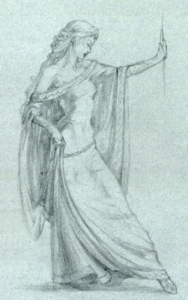
Artist: Tanya Geiger. Used with permission.
Design Notes
The elf subraces are highly varied in their power, but only drow and eladrin reach all that far. Well, and any avariel subraces that might be lying around. I’m least satisfied with the Barkskin feature of the SI/KG elves; something that scaled with your proficiency bonus would be more interesting. I love what the Wayfinder’s Guide to Eberron did with that, but it’s a lot more mechanical space than I want to take up.
With the Dragaerans, what I cared about – and what I think makes them more broadly applicable to other settings – is that I’ve never seen a version of elves that emphasized the benefits of extreme long life and a deeper connection to the cycle of reincarnation than other races. Elves are also usually political in a way that goes deeper than other races – the Silmarillion is just another example here.
There’s a pretty good chance I’ll write at least one more group of elf subraces, so that I can cover Dust to Dust’s Firstborn, SI/KG’s trow, and maybe the Noldor. But, well, if I’m going to do the Firstborn, I ought to try to write a whole character class for Firstborn magic. It’s… daunting.
In closing, a gallery of photos and sketches.
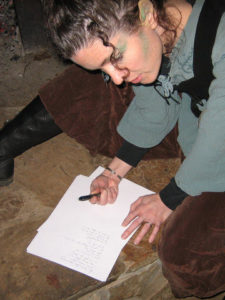
Photo subject Veaya Stembridge. Photographer unknown.
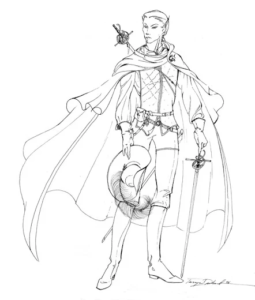
Artist: Tanya Geiger
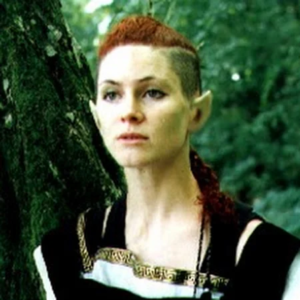
Photo subject Veaya Stembridge. Photographer unknown.
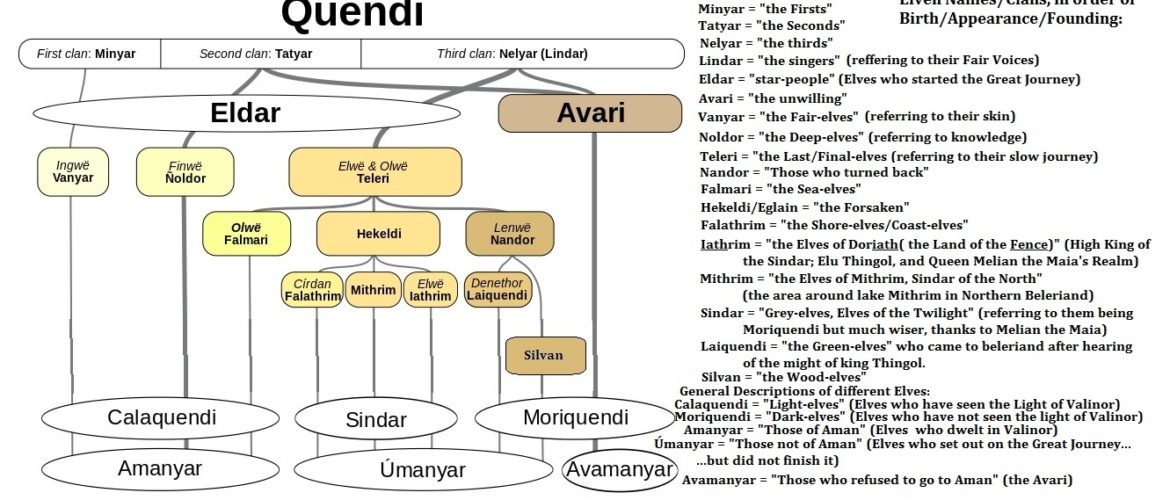

I think the druid is another class that can benefit from elven weapon proficiencies (specifically the longbow and shortbow).
Also, “cultivars” is a nice touch. Reminds me of the wood elves in the webcomic Guilded Age, who use plant metaphors for everything.
To some extent, yes, though the absence of an Extra Attack or Divine Strike-like feature to improve their weapon damage output means that at a certain point, it’s got to get phased out in favor of a cantrip or a concentration spell that offers an improved at-will option.